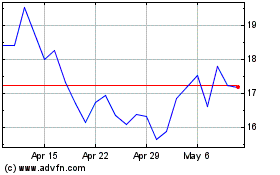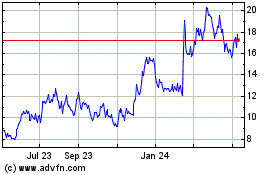California court grants stay on state law that would have
required reclassification Friday
By Preetika Rana
This article is being republished as part of our daily
reproduction of WSJ.com articles that also appeared in the U.S.
print edition of The Wall Street Journal (August 21, 2020).
Uber Technologies Inc. and Lyft Inc. will be able to continue
conducting business as usual in California for now, after a state
appeals court on Thursday paused a lower-court ruling that required
the ride-hailing companies to reclassify their drivers as
employees.
The reprieve means both companies can continue operating while
they fight a high-stakes legal battle with their home state.
The court's decision followed a flurry of public messaging by
the companies earlier Thursday, capping a week of threats that they
would shutter their services in California if the courts compelled
them to reclassify their workers. Lyft posted an announcement on
its website Thursday morning saying it would halt its business
there as of midnight. Uber put up what appeared to be a placeholder
post on its site, with the heading, "Important Information About
California Ridesharing Shutdown," which it later removed.
Lyft confirmed it no longer plans to halt ride-hailing service
in the state.
A state judge last week gave Uber and Lyft until Friday to
reclassify their drivers as employees, after California sued the
companies in May alleging they were violating a new state law.
California's so-called gig-worker law that went into effect on
Jan. 1 requires companies to treat workers as employees rather than
independent contractors if they are controlled by their employer
and contribute to its usual course of business, among other things.
As employees, drivers would be eligible for sick days and other
benefits, issues that have become more pressing during the
coronavirus pandemic.
Uber and Lyft, both based in San Francisco, have argued they are
technology platforms that connect riders with drivers, not
transportation companies, so the drivers aren't part of their usual
course of business.
California's Department of Justice, which is suing the
companies, said in a statement Thursday, "We're confident in the
facts of our case and we look forward to continuing our fight to
defend the rights of workers across the state."
While Thursday's stay opens the door for Uber and Lyft to
continue operating in a key market -- California accounted for 16%
of Lyft's rides in this year's second quarter and 9% of Uber's
gross bookings before the pandemic -- the prospect of reclassifying
drivers in the future would undermine the economics of ride-hailing
at a time the companies are already struggling to turn a
profit.
After the lower court ruling, Uber and Lyft bargained for more
time in legal filings to the appeals court that granted the stay.
Uber said, for instance, that it would take several months to build
a framework to reclassify drivers, including a system to monitor
their meals and rest breaks, and would need additional staff to
oversee day-to-day operations. Lyft, too, said it lacked the
infrastructure necessary to upend its business "at the flip of a
switch."
The companies have their sights on a November ballot initiative,
in which voters in California can decide whether to exempt them
from the state law at the heart of the dispute. The outcome of the
vote would supersede any pending litigation.
The court gave Uber and Lyft's chief executives until Sept. 4 to
submit sworn testimony saying they had developed the infrastructure
needed for such a reclassification should their ballot measure and
appeal fail.
Uber and Lyft have said reclassifying drivers would require them
to work prescheduled shifts, robbing them of flexibility. For the
reclassification to be economically viable, the companies say they
would be forced to consolidate their fleet to fewer drivers who
work 40 hours a week, the standard for full-time employees;
drastically reduce their footprint in cities where demand is
spotty; and raise prices for rides to offset the new costs
associated with managing driver operations.
Uber, for instance, said it would be able to hire just a quarter
of its more than 200,000 drivers in California and raise prices for
rides as much as 120% to account for the millions of dollars it
would need to invest to manage drivers as employees.
Bruce Schaller, a former deputy commissioner at the New York
City Department of Transportation, said the California law doesn't
require drivers to work fixed hours or full time. "Many people work
as part-time employees and still have flexibility," he said. "It's
ludicrous for them to hide behind that argument when they have
leeway to structure this the way they want."
He also said the companies were exaggerating the potential costs
and fare increases as a way to rally public support for their
cause. "They already do those things. Are they saying they don't
have a computer system with drivers' names in it, or a team to
onboard and check backgrounds, or that they don't process payments
to drivers or track their movements? They do everything and
more."
California Assemblywoman Lorena Gonzalez, who wrote the law at
the heart of the dispute, tweeted: " Uber & Lyft can quit
crying now & work on reclassifying their drivers as
employees.... Shame on them with their scare tactics!"
If the November ballot succeeds, the companies say they will
guarantee new protections for workers, such as giving drivers 30
cents a mile driven to account for gas and other vehicle costs,
health-care subsidies for drivers who work 15 hours or more a week
and occupational-accident insurance coverage while on the job.
Critics say those protections fall short compared with the
benefits awarded to employees. For instance, the standard Internal
Revenue Service mileage rate that employers typically use to
reimburse employees is 57.5 cents a mile.
Write to Preetika Rana at preetika.rana@wsj.com
(END) Dow Jones Newswires
August 21, 2020 02:47 ET (06:47 GMT)
Copyright (c) 2020 Dow Jones & Company, Inc.
Lyft (NASDAQ:LYFT)
Historical Stock Chart
From Mar 2024 to Apr 2024

Lyft (NASDAQ:LYFT)
Historical Stock Chart
From Apr 2023 to Apr 2024
